Top News
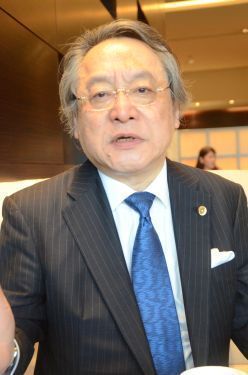
February 28, 2019 Ryukyu Shimpo
On February 27 the constitutional scholar and professor emeritus at Keio University, Setsu Kobayashi, spoke with the Ryukyu Shimpo about the results of the prefectural referendum on February 24 which asked Okinawans to vote “yes,” “no,” or “neither yes nor no” to land reclamation work as part of construction of the Futenma Replacement Facility in Henoko, Nago City.
Approximately 70 percent of all votes cast were “no” votes against the land reclamation work.
Kobayashi said, “A prefectural referendum is constitutionally binding.
In accordance with the intent of the Constitution the [central] government is obligated to pursue ‘relocation outside of the prefecture, at least.'”
Kobayashi based this on Article 95 of the Constitution.
The text of this article establishes that, “A special law, applicable only to one local public entity, cannot be enacted by the Diet without the consent of the majority of the voters of the local public entity concerned, obtained in accordance with law.” Furthermore, he pointed out that the referendum clearly demonstrates that Futenma Air Station’s relocation to Henoko has not earned agreement from a majority of Okinawans.
Noting that Article 95 refers to a “law,” Kobayashi explained that, “Although the relocation of the U.S. military facility to Henoko is not a ‘law’ in form, given that the Constitution intends to disallow the central government from bullying a region, the purpose of Article 95 is to provide a standard preventing the government from forcing an overlarge share of the [base] burden on Okinawa.”
Some doubt that opposition to land reclamation is truly the will of the Okinawan people.
Reasons indicated include that voter turnout only reached about half of the electorate, and the fact that there were approximately 700,000 Okinawan people who did not specifically cast a “no” vote.
Kobayashi refuted this, saying, “In the previous House of Representatives election in single-member districts, the LDP only got 47 percent of the votes, which accounted for about 25 percent of all eligible voters in those districts.
Nevertheless, the LDP acquired about 74 percent of the seats. It is hypocritical for the Abe administration to cite a low turnout rate in the prefectural referendum [as its reason to dismiss the results].”
Furthermore, Kobayashi voiced his opinion that the argument of low turnout is not applicable to the matter at hand.
He said, “The proportion of no votes to land relcamation in the prefectural referendum is overwhelmingly high compared to that of the LDP [votes in the aforementioned example].
It is a legal principle that those who abstain from voting abide by the outcomes wrought by those who turn out to vote.”
(English translation by T&CT and Erin Jones)
Go to Japanese
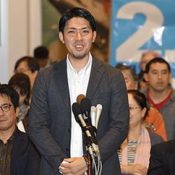
February 25, 2019 Ryukyu Shimpo
On the evening of February 24, “Henoko” Prefectural Referendum Council representative Jinshiro Motoyama held a press conference at the Education and Welfare Center in Furujima, Naha.
Regarding the referendum result, which showed a large majority of voters opposing the reclamation of land in Henoko, Nago, Motoyama stated, “The people’s will saying ‘no’ [to the reclamation] has been made even clearer.
The national government should pay great heed to the Okinawan people’s sentiment.
I want every person living in Japan to think of the issue as a matter in which they are involved.” He also said that the more than 50% voter turnout rate was “extremely good.”
After the council was established in April of last year, it gathered more than 100,000 signatures and petitioned for the enactment of a bylaw.
Despite encountering difficulties, the council managed to accomplish its aim of a prefecture-wide referendum under the slogan, “Okinawans will decide for Okinawa.”
At the press conference, Motoyama emphasized the significance of the referendum having been held, saying, “It was a step toward greatly advancing democracy in Okinawa.” He expressed his resolve, saying, “This is not the end. I want to continue dialogue among Okinawans and overcome divisiveness.”
(English translation by T&CT and Sandi Aritza)
Go to Japanese
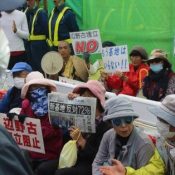
February 25, 2019 Ryukyu Shimpo Digital Edition
[Henoko Base Problem News Crew]The Japanese government continues to force through new base construction at Henoko, part of the relocation of MCAS Futenma, just one day after a resolution vote was held in Okinawa in which over 43,000 people voted “Oppose” to the construction.
At the gate of Camp Schwab in Henoko, around 60 staged a sit-in in protest. They raised their voices angrily stating, “We will not allow the will of the people to be ignored anymore. Is this what a democratic nation does?”
Starting early in the morning, citizens distributed by car papers displaying the result of the referendum as well as placards stating messages like “Don’t destroy our oceans.” At 9:30, when trucks began to arrive at the gate carrying construction material, police in riot gear forcefully removed the protesters.
The riot squad removed protestors one after another, interrupting citizens cries like “In your heart you oppose it to, don’t you?”
The trucks continued on into the base with the construction material, leaving vehicle exhaust in their wake.
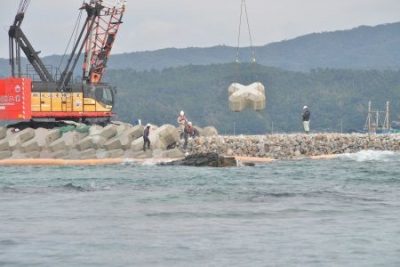
February 25, the day after a referendum vote in Okinawa, construction workers are seen stacking blocks at the N4 Seawall
The Okinawa Defense Bureau (ODB) continues forcing through their construction on the water.
Blocks were seen being stacked at the “N4 Seawall” near the tip of Cape Henoko.
A fleet of nine canoes carrying protesters went out to meet them, angrily demanding the government consider the voter’s choice.
Akiko Yamaguchi ,55, who let the protest fleet, said, “Why on earth is the government not acting in accordance with the will of the people?
Not a single Japanese person should allow this. We want them to hear the cries of Okinawa.”
(English translation by T&CT and Sam Grieb)
Go to Japanese
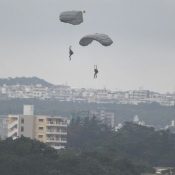
February 21, 2019 Ryukyu Shimpo online edition
Around 5:18 p.m. on February 21 the U.S. military carried out parachute drop training at Kadena Air Base.
This is the second such training this year, following the training on January 23. Kadena Town and Chatan Town received notification about the parachute drop training, and requested that the Okinawa Defense Bureau stop the training.
However, the U.S. military still conducted the training exercises.
In 1996 the Japan-U.S. Special Action Committee on Okinawa (SACO) agreed to conduct parachute drop training at the Ie Jima Auxiliary Airfield.
The SACO additionally agreed to “use Kadena Air Base only in exceptional cases,” in 2007. Since the SACO agreement in 1996, this instance of parachute drop training at Kadena Air Base was the eleventh.
Local municipalities repeatedly requested that this training cease as it violates the SACO agreement.
After the parachute drop training in January, the Three-City/Town Liaison Council on U.S. Military Kadena Air Base (Three-Party Council), which is comprised of representatives from Okinawa City, Kadena Town, and Chatan Town, met with the commander of Kadena Air Base’s 18th Wing, Brigadier General Case Cunningham, on February 1 and asked him directly not to conduct training.
(English translation by T&CT and Megumi Chibana)
Go to Japanese
February 25, 2019 The Ryukyu Shimpo
The voters’ disapproval was made clear in the results of the prefecture-wide referendum on the construction of a new U.S. military base in Henoko, Nago City.
It was the first time Okinawans voiced their opinions in a democratic process over construction of a specific military base. Feb. 24 will henceforth be a noteworthy day in Okinawan history.
The referendum is not legally binding, and yet a majority of Okinawans voted.
Over 430,000 citizens delivered a resounding “no” to constructing a new base. It is utterly unacceptable for Tokyo to ignore this fact.
The central government must respect the referendum verdict and immediately cease construction of the new base.
As for U.S. Marine Corps Air Station Futenma, which is located in the center of a crowded residential area, we’d like to see negotiations with the U.S. to close the base without relocation options.
The first step is to present the unvarnished referendum verdict to Washington, and ask for some level of understanding.
It is not the best policy for the United States to place a base where the locals oppose it.
It will be sensible to acknowledge the wishes of Okinawans.
Okinawa was cornered into holding this referendum by the Abe administration, which continues to be subservient to the U.S., and also pays no heed to the results of the Okinawan gubernatorial election.
Behind the administration are the many citizens who assume U.S. bases belong in Okinawa, or are simply uninterested.
If more people throughout Japan are now giving thought to this issue as if it were their own because of the referendum, it would add even more meaning to the polling.
What set the closure of MCAS Futenma into motion was the 1995 rape incident.
Due to high public demand to consolidate and reduce the U.S. military bases at the time, the American and Japanese governments agreed in 1996 to close MCAS Futenma within five to seven years.
Initially, the agreement included building heliports and relocating Futenma’s helicopter units to other existing U.S. bases in Okinawa, such as Kadena Air Base.
The plan has since been convoluted into a massive construction project.
The prefecture-wide referendum held 23 years ago saw strong demands to consolidate and reduce the military bases.
Nonetheless, construction work will go on today, against the will of many Okinawans, which is an alarming situation.
The central government has repeatedly stated that relocating MCAS Futenma to Henoko is “the only solution.”
This merely means that relocation is the only solution for the Abe administration.
Even if the new base is constructed, there are no assurances that Futenma will be returned to Okinawa.
Just as the promise to close the base “within five years” was broken, there is a high probability various reasons will be offered to rationalize postponement of returning Futenma.
Furthermore, feasibility of the construction itself is in question.
The soft seabed of the site necessitates installation of 77,000 piles for ground-improvement.
At 90 meters underwater, such a large-scale project has never been done anywhere else in the world; Construction costs will exceed the 2.55 trillion yen initially estimated by the prefecture.
Not only does building this base go against the will of the Okinawan people, it is an outrageous project that squanders taxpayer money.
We hope to see Gov. Denny Tamaki leverage Okinawa’s resolution to steadfastly negotiate with Tokyo.
(English translation by T&CT and Monica Shingaki)
Go to Japanese
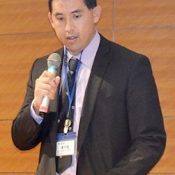
February 21, 2019 Ryukyu Shimpo
On February 20, Robert Kajiwara gave a speech at a rally in the Diet building. Robert Kajiawara is a fourth-generation Okinawan American singer-songwriter who created a petition addressed to the U.S. White House in hopes of halting the new base construction in Henoko of Nago City, Okinawa Prefecture.
He criticized the lack of response both by the Japanese and American governments despite collecting 210,000 signatures.
He also made it clear that he escalated the situation to the United Nations Human Rights Council (UNHRC) since “Uchinanchu are being neglected.” Looking back on the history of Okinawa, Robert points out that in the background of the bases being concentrated in Okinawa is “Japan’s long (history of) ethnic prejudice against Uchinanchu.”
Robert said, “The unfair Japan-U.S. Status of Forces Agreement should be revised.” He also said one of reasons why the agreement has not been reconsidered is because there is a “Not In My Backyard” mentality by those outside of Okinawa. U.S. military facilities being concentrated in Okinawa “Is fine because it is not their problem.”
With that in mind, Robert expressed his concerns should the new base construction continue. He said, “If situations like this continue, then the people of Okinawa will need to consider independence or expanding their autonomy.”
During the conference with Diet members that preceded his speech, Robert talked about the Referendum in Okinawa and the casting and counting of the votes on February 24.
Regarding the significance of this, he said, “This is not the end, but the beginning. This will be the renaissance to renew our understanding of Okinawa’s history, culture and language.”
U.K. rock band Queen guitarist and astrophysicist Brian May sent a message that read, “You must succeed.” Musician Ryuichi Sakamoto said via a video message, “It’s ridiculous that the national policy involves shoving the heavy burden of housing the bases on Okinawa.”
(English translation by T&CT and Chelsea Ashimine)
Go to Japanese
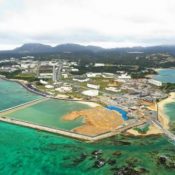
February 22, 2019 Ryukyu Shimpo
It has come to light that the estimated amount of sand needed for the Japanese government’s ground reinforcement work on the expanse of soft seafloor in Oura Bay, as part of Futenma Replacement Facility (FRF) construction in Henoko, has increased to almost 6.51 million cubic meters of sand.
This is approximately 11 times the initial estimate for the FRF construction plan, which was 580,000 cubic meters of sand. Some of this sand will be used in the soft seafloor directly under a strip where a seawall is to be built.
This sand is to be used as sand pillars in the “sand compaction pile method,” in which sand pillars will be driven into the soft seafloor and compacted, replacing 70 percent of the weak soil.
Since inserting the sand pillars might cause the seafloor to rise at most by about 10 meters, the caissons (concrete boxes) for the seawalls may need to be redesigned to compensate for the height change.
On February 21 at a plenary session of the Okinawa Prefectural Assembly, Okinawa Governor Denny Tamaki mentioned that due to clarifications about the scale of the ground reinforcement work, the Okinawa Prefectural Government (OPG) initial cost estimate of 50 billion yen has now reached 150 billion yen.
Taiga Teruya of the Social Democratic Party and Okinawa Social Mass Party coalition in the Prefectural Assembly answ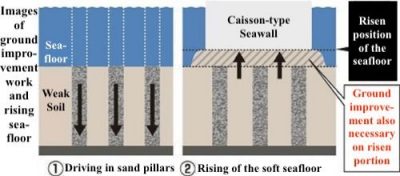 ered inquiries.
ered inquiries.
The Okinawa Defense Bureau (ODB) recorded the amount of sand needed for ground reinforcement in Oura Bay in its analytical materials about ground improvement work.
This fact was included in the OPG’s written statement submitted to the Ministry of Land, Infrastructure, Transport and Tourism (MLIT) on February 20, a part of the MLIT’s review of the OPG’s land reclamation permit revocation as requested by the ODB.
If it were not for ground reinforcement work, in construction of the FRF only 580,000 cubic meters of sand would be needed, which would be used to fill the caissons for the seawalls.
In the ODB’s application to the OPG for a land reclamation permit, it is stated that the sand will be “procured in the vicinity of Okinawa Island.”
According to the OPG, about 1.22 million cubic meters of sand was collected from within Okinawa Prefecture in 2014, 1.39 million cubic meters in 2015, and 1.84 million cubic meters in 2016.
If the government attempts to collect approximately 6.51 million cubic meters of sand, the amount necessary for ground reinforcement from within Okinawa Prefecture, it will take between three and five years to collect.
Initially, the large-scale caissons for use in the seawalls were designed to be 22 meters wide, 24 meters tall, and 52 meters long. However, adjusting for ground reinforcement work, the height of the caissons is estimated to change by 14 meters.
(English translation by T&CT and Erin Jones)
Photograph description:
Soil deposits into the land reclamation area and work on extending the N4 seawall continue on February 13 on the coast of Camp Schwab in Henoko, Nago City. (Photograph taken via small drone)
Go to Japanese
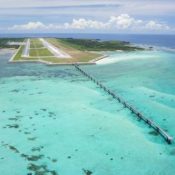
February 22, 2019 Ryukyu Shimpo
Hong Kong Express, a Hong Kong-based low cost carrier (LCC) announced February 21 that they would begin flying direct between the new Miyako Shimoji-shima international terminal in Miyakojima City, scheduled to open March 30, and Hong Kong three times per week starting July 19.
This is the first such international route for the Miyakojima region.
The route is expected to service around 28,000 people annually.
The company also began selling tickets the same day to go along with the formal announcement.
Until 12:59 a.m. on February 25, they will be selling tickets for flights between July 19 and October 26 at a special one-way fare of 2,280 yen.
On the new route, the carrier will fly a 180-passenger Airbus A320.
The flights are planned to depart every Tuesday, Friday, and Sunday.
The flights are expected to increase demand at the local resorts from travelers from Hong Kong and other countries, and will allow local residents an easy path to traveling abroad.
Hong Kong Express has a history of success with flights to destinations within Okinawa such as Ishigaki. They have been dubbed one of the 10 safest LCCs in the world by airline research groups.
Okinawa Governor Denny Tamaki commented on the new route, “I am very happy by the news. From now, we will work with Hong Kong Express as well as other involved in the project to invite many people to the Miyakojima region from Hong Kong and other places in the Asia-Pacific region.”
Another LCC, Jetstar Japan, will also be launching a domestic route between the new airport and Narita to coincide with the terminals opening March 30.
There are also plans for route with Korean Air Lines (KAL) as well as charter flights.
Okinawa Prefecture, the Okinawa Tourism and Convention Bureau, Miyakojima City, the airport facility construction company Mitsubishi Estate, and Shimoji-shima Airport Management, who will be operating the airport, continue working at enticing more airlines to run routes through the new airport.
(English translation by T&CT and Sam Grieb)
Go to Japanese
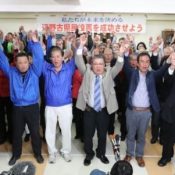
February 25, 2019 Ryukyu Shimpo
On February 24, a prefectural referendum was held asking Okinawan voters about their approval or disapproval of the land reclamation work as part of construction of the Futenma Replacement Facility (FRF) taking place on the shore portion of Camp Schwab.
According to results of same-day vote counting, in which 100 percent of the ballots were counted, 72.15 percent voted “no” to land reclamation, accounting for 434,273 individual votes.
Since more than one-fourth of registered voters (a total of 37.65 percent) selected “no” to land reclamation, the prefectural referendum ordinance states that the result should be respected, and requires a compulsory notification to the Prime Minister of Japan and the President of the United States.
Okinawa Governor Denny Tamaki stated that Okinawans have “once again put their bodies and souls into halting construction of the new base,” and stressed the possibility of requesting a review of the government’s method for closing and returning Futenma Air Station as soon as possible.
He is planning a visit to Tokyo, soon, to deliver notification of the prefectural referendum results.
Prime Minister Shinzo Abe has indicated he is willing to have a discussion with Governor Tamaki within the week, if Governor Tamaki is so inclined.
Voter turnout exceeded half at 52.48 percent. Out of the total 601,888 votes cast, those who answered “yes” to land reclamation numbered 114,933 at 19.10 percent, and those who answered “neither” came to 52,682 at 8.75 percent.
Although the prefectural referendum is not legally binding, from here on out a focal point for the U.S. and Japanese governments will be deciding how to respond to the will of the Okinawan people as FRF construction moves forward.
Over the 23 years since 1996 when the U.S. and Japanese governments agreed to close Futenma Air Station, Okinawa has demonstrated its clear opposition to construction of the FRF through channels such as gubernatorial and national elections, and now even in a prefectural referendum asking directly about the construction of the replacement facility.
Voter turnout in the prefectural referendum fell about 10 points short of the 63.24 percent turnout in the September gubernatorial election last year.
However, “no” votes to land reclamation outnumber the 396,632 votes polled in favor of Denny Tamaki for governor.
Henoko Kenmin Tohyo no Kai (represented by Jinshiro Motoyama), the group that directly appealed for a prefectural referendum ordinance in this matter, issued a statement upon hearing the results of the referendum.
It emphasized, “Now that clear opposition [to base construction in Henoko] has been demonstrated, it comes to question whether people on the mainland will individually recognize themselves as concerned parties, seeing as [the U.S.-Japan] security treaty and the relocation of Futenma Air Station outside of Okinawa or outside of Japan are matters for nationwide discussion.
” Additionally it stated, “The central government should renegotiate with the U.S. government, with removing the risk of Futenma Air Station [its closure and return] as the top priority. It should also immediately consider a policy that does not involve relocation within Okinawa.”
In 1996, there was a prefectural referendum that asked citizens about their support of base consolidation and reduction as well as revision of the U.S.-Japan Status of Forces Agreement (SOFA). At that time 89.09 percent voted in favor of these matters, which accounted for a majority of registered voters (53.04 percent). Voter turnout in the 1996 referendum was 59.53 percent.
(English translation by T&CT and Erin Jones)
Go to Japanese
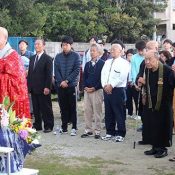
February 17, 2019 The Ryukyu Shimpo
Motobu City, Feb. 16—A memorial ceremony was held for Koreans who lost their lives during World War II, ahead of their exhumation from their burial site in Kenken, Motobu City.
In attendance and wishing for the remains to be returned to their families were Hideo Nakamura, 89, who found the bodies 74 years ago; and Kim Hong-gul, third son of the late former President Kim Dae-jung, and chairman of the Korean Council for Reconciliation and Cooperation, who wished for the remains to be returned to their families.
About 50 attendees were present, including members of the Truth-Seeking Organization on Seized Koreans, Okinawa Han no Hi monument Association and students from Korea University as well as universities of other prefectures. The Korean Council for Reconciliation and Cooperation expects to exhume the remains resting in Motobu City in May, and will timetable specifics with the landowner and other parties involved.
Kim gave his remarks at the service, stating his wishes to “exhume the remains spread across Japan and lay them to rest in the demilitarized zone of the Korean peninsula.
It may take time, but I intend to accomplish the task by all means.” He said that, “North and South Korea will join hands in the exhumation project,” and encouraged everyone in East Asia to “strive to build a bright future.”
In January of 1945, Hikosanmaru, a Japanese military transport ship, was met with U.S. airstrikes on the coast of Motobu City, resulting in the deaths of 14 army civilians aboard, including two Koreans.
Their bodies were buried across from Nakamura’s home in Kenken.
Nakamura said he “lined up the bodies and cremated them with wood. I didn’t tell anyone, because I inhumed the remains on someone’s land. I’ve been maintaining the site over the years, but no one paid attention.”
After the war, the status of Koreans mobilized in the Battle of Okinawa was not confirmed, and many of their bodies have not been returned home.
Following the inter-Korean summit held last April, Kim visited North Korea on Feb.
7 with the permission of the South Korean government.
He announced that he will be working together with Japanese and North Korean organizations to repatriate the bodies of Koreans mobilized by the Japanese government before and during the war.
(English Translation by T&CT and Monica Shingaki)
Go to Japanese
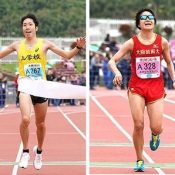
February 17, 2019 Ryukyu Shimpo Digital Edition
Chubu – The 27th Annual 2019 Okinawa Marathon (hosted by the Chubu Metropolitan Association, the Ryukyu Shimpo, Okinawa Television Broadcasting, the Japan Association of Athletics Federations Okinawa, the TrusTec Mizuno Okinawa Sports Park Management Joint Venture Group, and the Okinawa High School Athletic Union) set off from the Okinawa Comprehensive Athletic Park in Okinawa City February 17.
The event was sponsored by Aeon Mall Okinawa Rycom, Dai-ichi Life Insurance, The Bank of Okinawa, Orion Beer, and Okinawa Coca-Cola Bottling.
The men’s race was won by Suguru Otaguro (Saitama Association of Athletics Federations) with a time of 2 hours, 23 minutes and 44 seconds.
The women’s race was won by Yume Nagayama (Osaka University of Arts) with a time of 2 hours, 42 minutes and 15 seconds, a new record for Okinawa.
The previous record was held by Mariko Asato at 2 hours 42 minutes 1 second.
The 10 km men’s race was won by Yuta Hokama with a time of 31 minutes and 13 seconds.
The women’s 10 km was won by Mari Hanada with a time of 38 minutes and 1 second.
The high school 10 km men’s race was won by Kousuke Yamashiro (Koza) with a time of 31 minutes and 33 seconds, and the women’s high school 10 km was won by Hana Yoshimoto (Nago) with a time of 38 minutes 33 seconds.
The runners set off with the firing of the starting gun, and raced through the pleasant winter Chubu roads at a brisk pace.
The streets were lined with volunteers made up of local residents and businesses, cheering on the runners to their goal.
There was also a team marathon race for boys and girls, where 23 teams of boys (teams of 5 runners and up) and three teams of girls (teams of 3 runners and up) for a total of 186 youth runners competed.
Cheering one another on, the teams raced for the fastest time.
At the opening ceremony, race committee chair and Okinawa City Mayor Sachio Kuwae urged runners on, saying, “Do your best, using the warm encouragement from the nine Chubu villages.”
The Japan Association of Athletics Federations announced that 12,193 runners completed the full marathon (runners were only counted from 9:00 a.m. to 3:15 p.m.) and the 10 km race was completed by 3,225 runners (similarly counted from 9:40 to 11:00 a.m.) for a total of 15,418 participants.
(English translation by T&CT and Sam Grieb)
Go to Japanese







 ered inquiries.
ered inquiries.



 Webcam(Kokusai Street)
Webcam(Kokusai Street)


